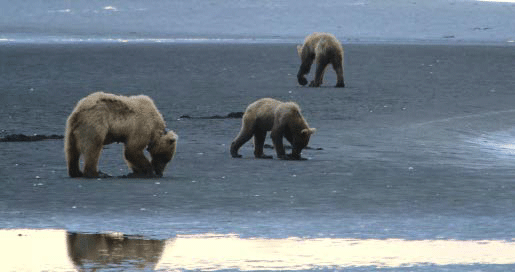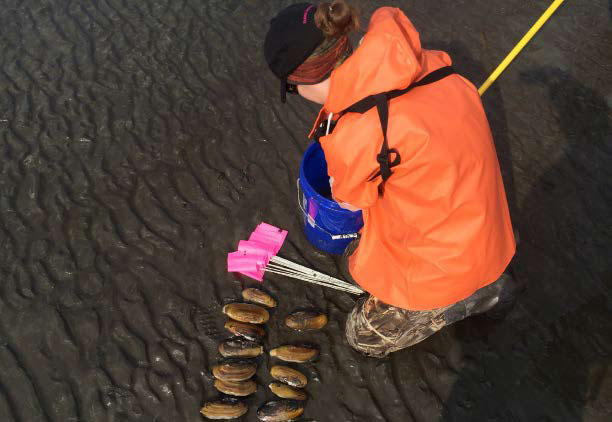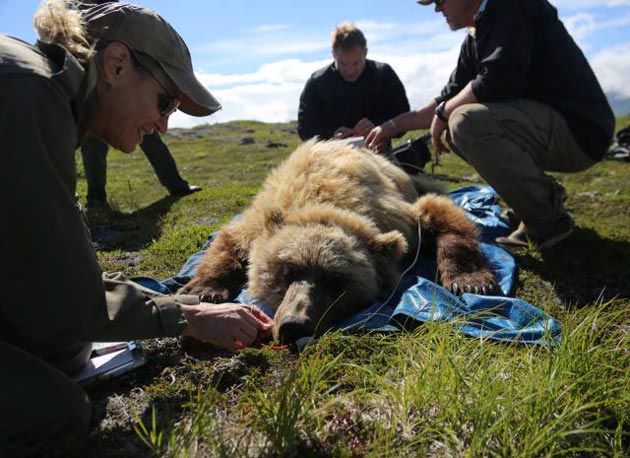Changing Tides is a three-year project investigating the relationships between coastal brown bears, people and marine intertidal invertebrates such as mussels and clams.

NPS Photo
Invertebrates Collected to Monitor Ocean Change
During the Southwest Alaska Network’s annual nearshore monitoring trip along the Katmai Coast in July, a variety of mussels and clams were collected, including samples of several species known to be consumed by bears that forage in intertidal areas. Species collected include the Pacific blue or bay mussel (Mytilus trossulus), the Pacific razor clam (Siliqua patula), the butter clam (Saxidomous gigantea), and Mya and Macoma clams.
Clams and mussels were kept alive in small aquarium-like containers and transported to the Alaska SeaLife Center to be measured for information such as length, width, total weight, shell weight, and shell thickness, as well as feeding rates and caloric content. Additional clams and mussels were dissected to obtain gill and mantle tissues, which were preserved. These tissue samples will be used to measure expression of a selected set of genes to evaluate the health of individual bivalves and their response to a variety of physiologic stressors.
Examples of stressors to which the bivalves may be exposed, now or in the coming years, include elevated temperatures, pH changes in marine waters (ocean acidification), pollutants, and pathogens. Overall, the multiple measurements obtained on the clams and mussels will allow us to compare the health of bivalve populations at different sites, assess their responses and sensitivity to environmental stressors, and quantify their energetic value as bear prey.

NPS Photo
Bear Feeding Activities at Hallo
To better understand bear foraging efforts, Joy Erlenbach, a PhD student at Washington State University, is observing the feeding activities of coastal brown bears at Hallo Bay throughout the summer. Among observation activities is an hourly scan of bears in various feeding habitats as well as a focused monitoring of a random bear for an hour; noting actions such as the number of bites of sedge taken, fish caught, clams dug, and minutes slept. These observations will provide insight into the foraging efforts of brown bears in three habitat types: meadows, streams, and intertidal areas. Joy has also seen collared bear 085 foraging at Hallo Bay with her two cubs.

NPS Photo
Bear Movement and Health Screening
In May, nine female coastal brown bears were fitted with GPS collars. Six of these bears were recaptured in mid-July. The bears were weighed, had their body fat content assessed, and had hair and blood samples taken to determine their diet.
Since May, biologists have been tracking each bear’s movement along the coast. In general, bears stayed within relatively small areas during the first part of the season. Between late-May and mid-July, the bears gained an average of 72 pounds. One bear gained an astounding 140 pounds while caring for three yearling cubs and before the salmon run had reached area streams. The measurements and samples collected from the bears will be used to evaluate and compare changes in body condition during the early foraging and late foraging seasons.
Changing Tides: June & July Bear Locations
A map showing where collared bears spent their time in June and July, 2015
The map above shows daily location data uploaded from the GPS collars of seven of the nine collared bears from June 1 through July 31.
Each bear is represented by different colored set of dots. Most of the bears have stayed within a relatively small home range. Note bear 085’s (pink) location on Ninagiak Island, where she spent weeks with her cubs before moving to Hallo Bay on July 9.
Questions or Comments?
Carissa Turner, Coastal Biologist
Katmai National Park, King Salmon, AK
(907) 246-2104
Grant Hilderbrand, Wildlife Biologist
NPS Alaska Region, Anchorage, AK
(907) 644-3578
Part of a series of articles titled Changing Tides Articles.
Last updated: July 20, 2016
